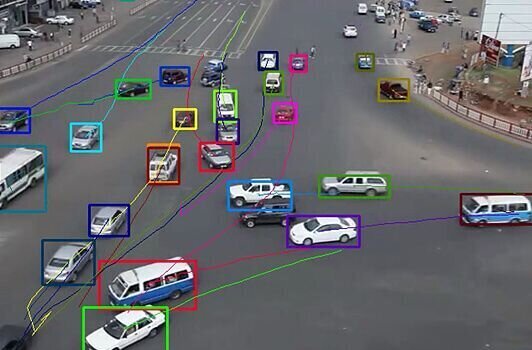Object Tracking Overview
Object tracking is a crucial aspect of computer vision that involves monitoring the movement of objects across video frames. This task is particularly challenging when multiple objects are present, as it requires not only detecting objects but also maintaining their identities over time. Several algorithms have been developed to address these challenges, with SORT (Simple Online Real-Time Tracking) and Deep SORT being among the most prominent.
SORT (Simple Online Real-Time Tracking)
SORT is a foundational algorithm for real-time object tracking, introduced in 2017. It employs a combination of a Kalman filter for state estimation and the Hungarian algorithm for data association. The process involves several key steps:
-
Detection: Objects are detected in each frame using an object detection model, such as Faster R-CNN or YOLO.
-
Estimation: The Kalman filter predicts the future position of each object based on its previous states, which includes position and velocity.
-
Data Association: The algorithm computes a cost matrix based on the Intersection over Union (IoU) between predicted and detected bounding boxes. The Hungarian algorithm is then used to optimally match detections to existing tracks.
-
Track Management: New tracks are created for unmatched detections, while tracks that have not been updated for a specified number of frames are deleted[1][3].
SORT is effective but can suffer from identity switches, particularly in scenarios involving occlusions or fast-moving objects.
Deep SORT
Deep SORT enhances the capabilities of the original SORT algorithm by integrating deep learning techniques to improve tracking accuracy and robustness. Introduced in 2019, Deep SORT incorporates appearance information into the tracking process, which significantly reduces identity switches during occlusions.
-
Feature Extraction: Deep SORT uses a convolutional neural network (CNN) to extract appearance features from detected objects. These features are represented as embeddings.
-
Cost Matrix Calculation: Instead of relying solely on IoU, Deep SORT combines motion-based predictions from the Kalman filter with appearance-based similarities using a cosine distance metric. This dual approach allows for more reliable tracking, especially in complex environments[1][2][3].
-
Data Association and Track Management: Similar to SORT, Deep SORT employs a cost matrix for data association but includes both motion and appearance metrics. This helps in accurately associating detections with tracks, even when objects are occluded or move quickly.
Applications and Frameworks
Object tracking has a wide range of applications, from surveillance systems and traffic monitoring to sports analytics and autonomous vehicles. The integration of models like YOLO (You Only Look Once) with Deep SORT allows for real-time tracking and detection, making it suitable for various real-world scenarios[4][5].
In conclusion, object tracking frameworks like SORT and Deep SORT represent significant advancements in the field of computer vision, enabling more accurate and efficient tracking of multiple objects in dynamic environments. These models continue to evolve, leveraging deep learning to enhance their performance and applicability across diverse tasks.
Further Reading
1. Understanding Multiple Object Tracking using DeepSORT
2. DeepSORT: Deep Learning to track custom objects in a video
3. Object Tracking – SORT and DeepSort
4. Object Tracking Using YOLOv4, Deep SORT, and TensorFlow – YouTube
5. https://github.com/heejae1213/object_tracking_deepsort


